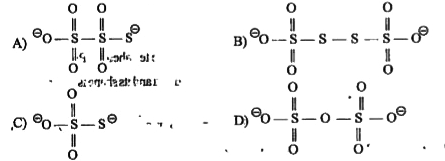There is no S - S bond in : S2O2−6, S4O2−6, S2O2−3, S2O2−7Solution in Malayalam
S2O2−6
S4O2−6
S2O2−3
S2O2−7
The correct Answer is:D
Topper's Solved these Questions
- BOOK - BRILLIANT PUBLICATIONCHAPTER - CHEMICAL BONDINGEXERCISE - LEVEL-II100videos
CHEMICAL BONDING
- BOOK - BRILLIANT PUBLICATIONCHAPTER - CHEMICAL BONDINGEXERCISE - LEVEL-II (ASSERTION-REASON TYPE)20videos
CHEMICAL BONDING
- BOOK - BRILLIANT PUBLICATIONCHAPTER - CHEMICAL BONDINGEXERCISE - LEVEL-III ( Linked Comprehension Type )12videos
CHEMICAL BONDING
- BOOK - BRILLIANT PUBLICATIONCHAPTER - CHEMICAL AND IONIC EQUILIBRIUMEXERCISE - Level - III (Linked Comprehension Type Questions)1videos
CHEMICAL AND IONIC EQUILIBRIUM
- BOOK - BRILLIANT PUBLICATIONCHAPTER - CHEMICAL BONDING AND MOLECULAR STRUCTUREEXERCISE - QUESTION (LEVEL -ll)42videos
CHEMICAL BONDING AND MOLECULAR STRUCTURE
Similar Questions
Polarising action of Cd2+ on anions is stronger than that of Ca2+ because
00:39View SolutionIn the following question, an Assertion (A) is followed by a corresponding Reason (R). Use the following keys to choose the appropriate answer.
Assertion : In case of (CH3)3N geometry is pyramidal, but in case of (SiH3)3N it is planar.
Reason : The maximum covalency of Si is six but that of C is four. : If both (A) and (R) are correct and (R) is the correct explanation of (A)., If both (A) and (R) are correct, but (R) is not the correct explanation of (A)., If (A) is correct, but (R) is incorrect., If both (A) and (R) are incorrect.01:08View SolutionIn an ionic bond, the cation tends to polarize the electron cloud of the anion by pulling electron dens towards itself. This causes development of covalent character in the ionic bond because the electron dens gets localised in-between the nuclei. The tendency of the cation to bring about the polarization of the anion expressed as its polarizing power. The ability of ion to undergo polarization is called its polarisability. The polarising power of a cation or an anion is decided on the basis of Fajans' rules.
The ionic conductance of which of the following is the highest?01:53View SolutionThe degre of dissociation of weak electrolyte is inversely proportional to the same square root of concentration. What is called Ostwald's dilution law.
α=√Kac As the temperature increases, degree of dissociation will increase.
α1α2=√Ka1Ka2 if concentration is same. α1α2=√c2c1 if acid is sam.
For two monobasic acids HA1 and HA2 at the same concentration α1 and α2 are in ratio of 1:2. Ka1=2×10−4. What will be Ka2 ? 8×10−4, 2×10−4, 4×10−4, 1×10−4View SolutionWhich of the following species are hypervalent ?
(l) ClO−4
(ll) BF3
(lll) SO2−4
(lV) CO2−300:52View Solutioniodine oxidises the S_2O_3^(2-) ion to
00:55View SolutionNumber of S-S bond in S_2O_7^(2-)
00:52View SolutionNumber of S-O bond in S_(2)O_(8) ^(2-) and number of S-S bond in Rhombic sulphur?
00:32View SolutionThe bond angle in H_(2)S
02:26View SolutionThe bond angle in H2S is
01:40View SolutionDipolemoment of H2S is 0.950. Find the S-H bond moment. Bond angle in H2Sis 96∘ and cos48∘ is 0.66
01:39View SolutionThe bond angle in H2S is
03:55View SolutionHow many S-S bond are there in S2O−27
04:22View SolutionNumber of S−O bond in S2O2−8 and number of S−S bond in Rhombic sulphur?
03:10View SolutionIodine oxidises S2O2−3ion to:
02:43View SolutionOxidation number of S in S2O2−3 :
02:48View Solution

